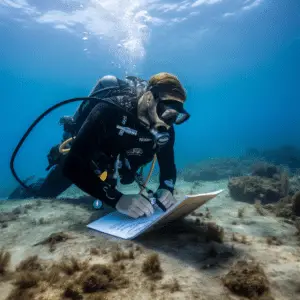Dive tables and scuba diving safety, Scuba diving safety and dive tables Scuba diving is complicated despite its image as a pleasant sport. It can be challenging to memorize and interpret so much information.Memorizing all of this information may seem overwhelming and unnecessary, but it’s necessary for your safety. You must learn your equipment as well as crucial data and safety guidelines.
Equipment is essential to scuba diving because it protects you in strange waters. Every year, scuba equipment improves and new products are released to make diving easier.
Technology has progressed throughout the decades, making scuba diving more sophisticated. This is shown in our phones and TVs, but in scuba, it’s seen in new and interesting equipment.
The world of scuba has changed so much that some of the equipment divers cannot live without is new. This includes full-face dive masks and computers. Diving computers are a relatively new addition to the large array of scuba diving equipment due to their importance in keeping divers safe. This may be unexpected, but picture what technology was like in the mid-1900s, when a dive computer was impossible. You may wonder how folks scuba dived without a dive computer. Dive tables were used before the dive computer, but what are they?
What are dive tables?

Scuba diving safety and dive tables For subsequent and initial dives, dive tables establish how long you can safely be submerged, depending on depth. Dive tables can be daunting and complicated, so an alternative was designed. In addition to staying fit, scuba divers must master safety protocols and descending depths. Before completing a PADI diver training, you must understand a dive table. This indicates that even if new technology can help you stay secure, you must still comprehend them.
Because technology might fail at any time, understanding how to map your own safety is a crucial scuba diving ability.
Dive tables have restrictions. They presume the diver will stay at the same depth throughout the trip, which seems dubious. You may float and alter depths when exploring water. Stay at the depth listed on a diving table to measure nitrogen absorption.
Knowing your nitrogen absorption can prevent decompression sickness, one of the deadliest diving conditions.
What is decompression sickness?
Dive tables and scuba diving safety, Decompression sickness, or the bends, occurs when rapid decompression causes nitrogen bubbles in the blood and tissue. Decompression illness is uncomfortable and inconvenient. There are other negative effects include muscular and joint discomfort and nausea. Though those symptoms are difficult, possible paralysis may be the worst. You don’t want to lose control of your body while diving. Decompression sickness was becoming widespread and deadly, therefore dive tables were invented.
You should know how to read them because they are very vital for your safety. Planning your trip could prevent bends.
How to read a dive table
Dive tables and scuba diving safety, For your normal recreational dive planner, you may calculate how long you can drive without decompression stops. If you’re not good at math, reading a diving table can be intimidating.
Pressure groups for repetitive diving have made reading the dive table easier.
Pressure groups
When you do your first dive, you should be able to work out what pressure group you fall under. This is worked out by looking at your tank’s 02 percentage and comparing it with the depth you are diving to. You then look at the depth you will be driving to and compare it to the time you will be diving for. For example, if you were diving to 70 feet for around 30 minutes, you would fall into pressure group I.
Calculating your pressure group for your second dive depends on remembering the details of your first dive. On top of this, you also need to remember your surface intervals, which will indicate the nitrogen levels that are still in your body. Working this out will allow you to know just how long you can stay in the water before it becomes unsafe.
Repetitive dive
You must calculate residual nitrogen time (RNT) if you plan to dive repeatedly using a dive table. The nitrogen in your body from your previous dive is this. The outcomes of your first dive and your initial pressure group determine this. If this is your third or fourth dive, you must log your figures precisely to make adjustments. For instance, you will need to adjust your dive time and create new decompression stops if you didn’t use them before.
Dive computer
A dive computer works in a different and more accurate way. As previously discussed, a dive table will only work on the assumption that you will be staying at the same depth for your entire dive trip, which we know will likely not be the case. A dive computer records an accurate time and depth that a scuba diver has reached during their dive, and they will use this to accurately calculate the level of nitrogen absorption that has actually occurred. This newfound accuracy that has come with the use of dive computers means that people can spend even longer under the water during their dive. It also means that people can take shorter surface intervals as in the past, people have had longer surface intervals due to inaccurate results just to be safe.
Do you need a dive table when you are using a dive computer?
Now, you don’t necessarily have to use a diver table if you have access to a dive computer. In fact, if you were to scuba dive in Florida, if you’re a beginner, you wouldn’t be asked to use a dive table during your first diving experience.
Due to the time required to grasp dive tables, if you are simply diving for a vacation, you will not need to learn how to read them.
Because dive computers are more accurate than dive tables, you don’t need one for scuba diving. If you want to dive as a hobby, you need learn how to read a dive table.
Reasons why you should learn how to read a dive table

If you are someone that is not convinced that learning how to read a dive table is worth your while, you may require more reasons as to why you should pick it up as a skill.
Technology is unreliable
Though fantastic and useful in our daily lives, technology is unstable. Scuba divers usually bring one dive computer. After all, they can be expensive, so having multiple wouldn’t make sense. Technology is also fickle, and your dive computer could work well one minute and break the next.If this happened while you were in the water, you could be in trouble. Checking the diving computer continually keeps you updated on your stats, not the dive itself. Unless you examined it recently, it could break and put you in a tough spot. However, if you had calculated dive table timing, you would be better off.
Although you may not follow your dive table timings exactly, you’re better off with one. Why not take extra scuba diving precautions? Your main focus is safety.
Expense
As I have previously discussed, dive computers can actually be extremely expensive. You can go to some places and find a dive computer at a decent price, but you can still expect to pay way over five hundred dollars for a quality diver computer. If you take this into account, along with all of the other bits of equipment that you need to buy, this can make your hobby super expensive.
You can’t eliminate oxygen tank costs. However, you can cut unnecessary components. People have dived without dive computers for a long time, therefore you don’t need one if you can read and follow a dive table. Having this skill is valuable regardless, and not owning a dive computer will simply drive you to improve your dive table reading. When learning to drive, you shouldn’t start with an automatic because it puts you at a disadvantage.
Company
If you plan on diving with a group of people and have the same oxygen levels and route, you could be ok not using a dive table in the unlikely event your drive computer breaks, as you will be able to get an idea of timing stats from them.
